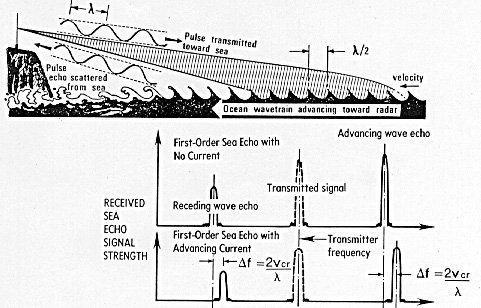

HF radio waves are used to measure surface ocean currents. The outgoing
radio wave, wavelength ![]() , resonantly Bragg-scatters from sea-surface waves of
wavelength
, resonantly Bragg-scatters from sea-surface waves of
wavelength ![]() /2 (upper sketch). If no current is present, the backscattered radio
waves are Doppler-shifted by the phase-speed of the surface waves toward
or away from the transmitter,
/2 (upper sketch). If no current is present, the backscattered radio
waves are Doppler-shifted by the phase-speed of the surface waves toward
or away from the transmitter, ![]() (middle sketch). If there is an ocean
surface current toward or away from the transmitter, it imposes an additional
Doppler shift on the backscattered wave. This additional shift is what indicates
the magnitude and direction of the current, either toward or away from the
transmitter (lower sketch). Range-gating is used to profile currents vs
distance from the transmitter. Compact multi-element receive antennas, with
peak sensitivity in orthogonal directions, to allow direction-finding to
assign an azimuth to each returning frequency band (i.e. each current estimate).
Maps of surface current vectors are constructed by combining simultaneous
measurements from two separated sites.
(middle sketch). If there is an ocean
surface current toward or away from the transmitter, it imposes an additional
Doppler shift on the backscattered wave. This additional shift is what indicates
the magnitude and direction of the current, either toward or away from the
transmitter (lower sketch). Range-gating is used to profile currents vs
distance from the transmitter. Compact multi-element receive antennas, with
peak sensitivity in orthogonal directions, to allow direction-finding to
assign an azimuth to each returning frequency band (i.e. each current estimate).
Maps of surface current vectors are constructed by combining simultaneous
measurements from two separated sites.